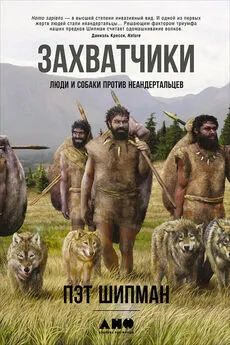Пэт Шипман - Захватчики: Люди и собаки против неандертальцев
- Название:Захватчики: Люди и собаки против неандертальцев
- Автор:
- Жанр:
- Издательство:Литагент Альпина
- Год:2016
- Город:Москва
- ISBN:978-5-9614-4412-4
- Рейтинг:
- Избранное:Добавить в избранное
-
Отзывы:
-
Ваша оценка:
Пэт Шипман - Захватчики: Люди и собаки против неандертальцев краткое содержание
В этой книге собраны убедительные доказательства того, что основным фактором гибели неандертальцев была прямая конкуренция с пришедшим на ту же территорию современным человеком. Опираясь на инвазивную биологию, которая говорит, что, чем вид ближе к инвазивным хищникам, с тем большей конкуренцией он столкнется, Пэт Шипман отслеживает разрушительное воздействие растущей популяции человека современного типа: сокращение ареала неандертальца, деление его популяции на небольшие группы и утрату генетического разнообразия данного вида.
Но не только современные люди конкурировали с неандертальцами. Шипман рассказывает о потрясающем партнерстве человека с первыми одомашненными волками-собаками, появление которых совпало с началом исчезновения неандертальцев. Автор выдвинула гипотезу, что союз двух хищников – человека и волка – позволил успешно охотиться на крупных млекопитающих ледникового периода, что дало решающее преимущество над неандертальцами, когда изменение климата сильно осложнило жизнь обеих групп рода Homo.
Захватчики: Люди и собаки против неандертальцев - читать онлайн бесплатно ознакомительный отрывок
Интервал:
Закладка:
45
Pinhasa et al. Revised Age of Late Neanderthal Occupation.
46
Higham T., Basell L., Jacobi R., Wood R. et al. Testing Models for the Beginnings of the Aurignacian and the Advent of Figurative Art and Music: The Radiocarbon Chronology of Geissenklösterle // Journal of Human Evolution. 62. 2012, 665.
47
Higham T., Compton T., Stringer C. et al. The Earliest Evidence for Anatomically Modern Humans in Northwestern Europe // Nature. 479. 2011, 521–524, doi: 10.1038/naturel0484
48
Higham T. et al. Timing and Spatio-Temporal Patterning.
49
Savoleinen P., Leitner T., Wilton A. et al. A Detailed Picture of the Origin of the Australian Dingo, Obtained from the Study of Mitochondrial DNA // Proceedings of the National Academy of Sciences USA. 101. 2004, 12387–12390.
50
Shipman P. The Animal Connection.
51
Zalasiewicz J., Williams M., Smith A. et al. Are We Now Living in the Anthropocene? // GSA Today 18. N. 2. 2008, 4–8, doi: 10.1130/GSAT01802A. l; Zalasiewicz J., Williams M., Steffen W. et al. The New World of the Anthropocene // Environmental Science and Technology. 44. 2010, 2228–2231; Crutzen P., Stoermer E. Tie Anthropocene // Global Change Newsletter. 41. 2000, 17–18.
52
MiiHer U., Pross J., Tzedakis P. et al. The Role of Climate in the Spread of Modern Humans into Europe // Quaternary Sciences Review. 30. 2011, 273–279; Хороший обзор представлен в публикации Национального центра климатических данных A Paleo Perspective on Abrupt Climate Change ( http://www.ncdc.noaa.gov/paleo/abrupt/data3.html).
53
Lowe J., Barton N., Blockley S. et al. Volcanic Ash Layers Illuminate the Resilience of Neanderthals and Early Modern Humans to Natural Hazards // Proceedings of the National Academy of Sciences USA. 109. 2012, 13532–13537, doi: 10.1073/pnas.l204579109; Hublin J.-J. Hie Earliest Modern Human Colonization of Europe // Proceedings of the National Academy of Sciences USA. 109. 2012, 13471–13472.
54
Lowe et al. Volcanic Ash Layers. 13532.
55
Lowe et al. Volcanic Ash Layers, с. 13536.
56
Arensburg B. Human Remains from Geula Cave, Haifa // Bulletins et memoires de la Societe dAnthropologie de Paris. 14. 2002, 141–148.
57
Shea J. The Archaeology of an Illusion: Hie Middle Paleolithic Transition in the Levant // Vie Lower and Middle Palaeolithic in the Middle East and Neighboring Regions. Eds. J.-M. Le Tensorer, R. Jagher, and M. Otte (Basel Symposium, Eraul, Liege). 2008, 169–182.
58
Brown K., Marean C., Jacobs Z. et al. An Early and Enduring Advanced Technology Originating 71,000 Years Ago in South Africa // Nature. 491. 2012, 590–593.
59
Shea. Archaeology of an Illusion. 177.
60
Demeter F., Shackelford L., Bacon A.-M. et al. Anatomically Modern Human in Southeast Asia (Laos) by 46 ka // Proceedings of the National Academy of Sciences USA. 109. 2012, 14375–14380.
61
Pierret A., Zeitoun V., Forestier H. Irreconcilable Differences between Stratigraphy and Direct Dating Cast Doubts upon the Status of Tam Pa Ling Fossil // Proceedings of the National Academy of Sciences USA. 109. 2012. E3523, www.pnas.org/cgi/doi/10.1073/pnas. 1216774109; см. также Demetera F., Shackleford L., Westaway K. et al. Reply to Pierret et al.: Stratigraphic and Dating Consistency Reinforces the Status of Tam Pa Ling Fossil // Proceedings of the National Academy of Sciences USA. 109. 2012. E3524-E3525.
62
Bae C., Wang W., Zhao J. et al. Modern Human Teeth from Late Pleistocene Luna Cave (Guangxi, China) // Quaternary International (принята к печати), исправленная редакция доступна онлайн с 28 июля 2014 г.
63
Higham et al. Earliest Evidence for Anatomically Modern Humans; Benazzi S., Douka K., Fornai C. et al. Early Dispersal of Modern Humans in Europe and Implications for Neanderthal Behavior // Nature. 479. 2011, 525–528; Higham T., Stringer C., Douka K. Dating Europe's Oldest Modern Humans // British Archaeology. Январь – февраль 2012 г., с. 24–29.
64
Trinkaus E., Moldovan O., Milota S. et al. An Early Modern Human from the Pestera cu Oase, Romania // Proceedings of the National Academy of Sciences USA. 100. 2003, 11231–11236; Higham et al. Dating Europe's Oldest.
65
Finlayson C. Neanderthals and Modern Humans: An Ecological and Evolutionary Perspective/Cambridge: Cambridge University Press. 2004.
66
Finlayson C. Neanderthals and Modern Humans: An Ecological and Evolutionary Perspective/Cambridge: Cambridge University Press. 2004, с. 153.
67
Finlayson C. Neanderthals and Modern Humans: An Ecological and Evolutionary Perspective/Cambridge: Cambridge University Press. 2004, с. 154.
68
Cahill A., Aiello-Lammens M., Fisher-Reid M. et al. How Does Climate Change Cause Extinction? // Proceedings of the Royal Society B. 280. 2013, 2–3.
69
Finlayson C. Neanderthals and Modern Humans. 153.
70
См. обсуждение в книге Trinkaus E., Shipman P. The Neanderthals/New York: Knopf. 1992.
71
C. Marean, из личных разговоров с автором, 25 января 2014 г.
72
Gause G. F. The Struggle for Existence/Baltimore: Williams & Wilkins. 1934.
73
Hardin G. The Competitive Exclusion Principle // Science. 131. 1960, 1292–1297.
74
Terborgh J., Holt R., Estes J. Trophic Cascades: What They Are, How They Work, and Why They Alter // Trophic Cascades: Predators, Prey, and the Changing Dynamics of Nature. Eds. J. Terborgh, J. Estes/Washington, DC: Island Press. 2010, 7.
75
См. Mac Arthur R., Wilson E. O. The Theory of Island Biogeography. 1967; Репринт Princeton, NJ: Princeton University Press, 2001.
76
Portmann A. A Zoologist Looks at Humankind/New York: Columbia University Press. 1990; Smith T., Tafforeau P., Reid D. et al. Dental Evidence for Ontogenetic Differences between Modern Humans and Neanderthals // Proceedings of the National Academy of Sciences USA. 107. 2010, 20923–20928.
77
Roemer G., Gompper M., Van Valkenburgh V. The Ecological Role of the Mammalian Mesocarnivore // Bioscience. 59. 2009, 165–173.
78
Grinnell J. The Origin and Distribution of the Chestnut-Backed Chickadee // The Auk (American Ornithologists' Union). 21. 1904, 364.
79
Van Valkenburgh B. Tracking Ecology over Geological Time: Evolution within Guilds of Vertebrates // Trends in Evolution and Ecology. 10. 1995, 71–76; Ripple W., Van Valkenburgh B. Linking Top-Down Forces to the Pleistocene Megafaunal Extinctions // Bioscience. 60. 2010, 516–526.
80
Patou-Mathis M. Neanderthal Subsistence Behaviours in Europe // International Journal of Osteoarchaeology. 10. 2000, 379–395; Grayson D., Delpech F. The Large Mammals of Roc de Combe (Lot, France): The Chatelperronian and Aurignacian // Journal of Anthropological Archaeology. 27. 2008, 338–362; Grayson D., Delpech F. Changing Diet Breadth in the Early Upper Paleolithic of Southwestern France // Journal of Archaeological Science. 25. 1998, 1119–1130; Grayson D., Delpech F. Specialized Early Upper Paleolithic Hunters in Southwestern France? // Journal of Archaeological Science. 29. 2002, 1439–1449; Grayson D., Delpech F. Ungulates and the Middle-to-Upper Paleolithic Transition at Grotte XVI (Dordogne, France) // Journal of Archaeological Science. 30. 2003, 633–640; Grayson D., Delpech F. Pleistocene Reindeer and Global Warming // Conservation Biology. 19. 2005, 557–562; Grayson D., Delpech F. Was There Increasing Dietary Specialization across the Middle-to-Upper Paleolithic Transition in France?/When Neanderthals and Modern Humans Met, ed. N. Conard. Tubingen: Kerns Verlag. 2006, 377–417; Grayson D., Delpech F., Rigaud J.-Ph. et al. Explaining the Development of Dietary Dominance by a Single Ungulate Taxon at Grotte XVI, Dordogne, France // Journal of Archaeological Science. 28. 2001, 115–125; Stiner M. Honor among Thieves: A Zooarchaeological Study of Neandertal Ecology. Princeton, NJ: Princeton University Press. 1994.
81
Stringer C., Finlayson J. C., Barton R. et al. Neanderthal Exploitation of Marine Mammals in Gibraltar // Proceedings of the National Academy of Sciences USA. 105. 2008, 14319–14324.
82
Bar-Yosef O. Eat What Is There: Hunting and Gathering in the World of Neanderthals and Their Neighbors // International Journal of Osteoarchaeology. 14. 2004, 333–342, doi: 10.1002/oa.765.
83
Richards M., Trinkaus E. Isotopic Evidence for the Diets of European Neanderthals and Early Modern Humans // Proceedings of the National Academy of Sciences USA. 106. 2009, 16034–16039.
84
Richards M., Pettitt P., Stiner M. et al. Stable Isotope Evidence for Increasing Dietary Breadth in the European Mid-Upper Paleolithic // Proceedings of the National Academy of Sciences USA. 98. 2001, 6528–6532, doi: 1073/Proceedings of the National Academy of Sciences USA. 111155298; Kuhn S., Stiner M. C. What's a Mother to Do? The Division of Labor among Neandertals and Modern Humans in Eurasia // Current Anthropology. 47. 2006, 953–980.
85
Bocherens H., Drucker D. Dietary Competition between Neanderthals and Modern Humans: Insights from Stable Isotopes/When Neanderthals and Modern Humans Met. Tubingen: Kerns Verlag. 2006, 129.
86
Bocherens H., Drucker D. Dietary Competition between Neanderthals and Modern Humans: Insights from Stable Isotopes/When Neanderthals and Modern Humans Met. Tubingen: Kerns Verlag. 2006, 136.
87
Bocherens H. Diet and Ecology of Neanderthals: Implications from C and N Isotopes/Neanderthal Life-ways, Subsistence and Technology: One Hundred Fifty Years of Neanderthal Study. New York: Springer. 2011, 73–85.
88
Fabre V., Condemi S., Degioanni A. et al. Neanderthals versus Modern Humans: Evidence for Resource Competition from Isotopic Modelling // International Journal of Evolutionary Biology. 2011. Article ID 689315, doi: 10.4061/2011/689315.
89
Salazar-Garcia D., Power R., Sanchis Serra A. et al. Neanderthal Diets in Central and Southeastern Mediterranean Iberia // Quaternary International. 318. 2013, 3–18; Salazar-Garcia D. Isotopos, dieta y movilidad en el Pais Valenciano: Aplicacion a restos humanos del Paleolitico medio alNeolitico final (Isotopes, Diet and Mobility in the Valencian Region; Application to Human Remains of the Middle Paleolithic and Final Neolithic) Ph. D. diss., Universitat de Valencia, 2012.
90
Интервал:
Закладка:



![Марта Стаут - Социопат по соседству [Люди без совести против нас. Как распознать и противостоять] [litres]](/books/1060204/marta-staut-sociopat-po-sosedstvu-lyudi-bez-sovest.webp)






